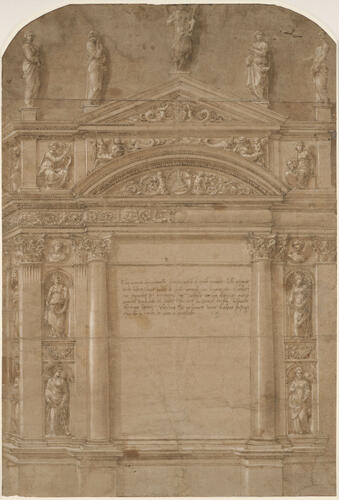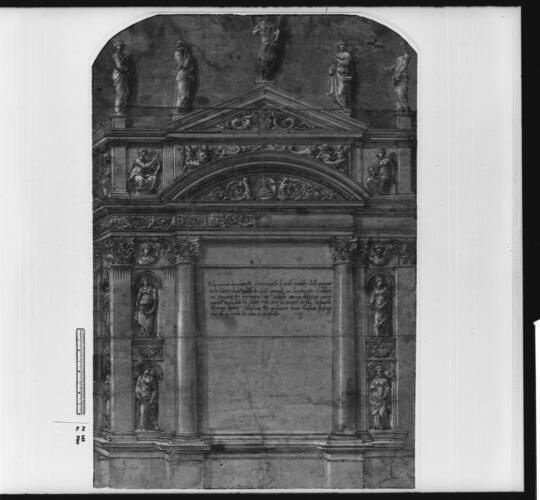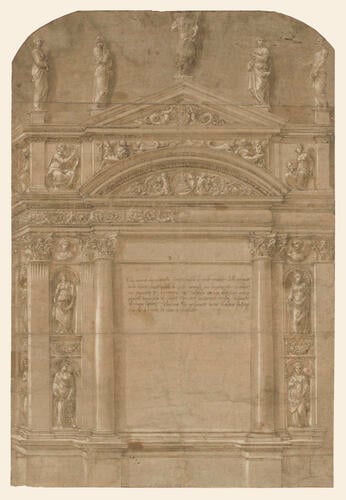-
1 of 253523 objects
A design for an organ case c. 1520
Pen and ink with wash and white heightening, on buff paper | 56.5 x 38.0 cm (sheet of paper) | RCIN 905495

Baldassarre Peruzzi (1481-1536)
A design for an organ case c. 1520

Baldassarre Peruzzi (1481-1536)
A design for an organ case c. 1520

Baldassarre Peruzzi (1481-1536)
A design for an organ case c. 1520




-
A large design for a secular organ case. At upper centre is the god of music Apollo, accompanied by the Muses, inspirational goddesses of the arts. In the pediments are the emblems of Federico Gonzaga, marquis (and later duke) of Mantua. Peruzzi’s design was probably drawn in Rome and sent to Mantua for local carpenters and woodcarvers to construct. At the centre, where the organ pipes would be, Peruzzi notes possible adjustments to the design:
'FIDES / B / E da notare che inquesta faccia vaño le cañe piccole delo organo / & da laltra dove vaño le cañe grandi va levato via el collari/no segnato .B. preterea sepo volendo tor via el fastigio overo / quarto tondo socto ali satyri e qui dare la cornice dricta ussando / el fastigio sup[er]iore. Vlterius se po levare luno e laltro fastigio / e farlo a modo de arco triumphale'
[‘It is to be noted that the small pipes of the organ are on this side and that, on the other, where the large pipes are, the frieze marked B is left out. Besides, if it is desired, the pediment or quarter-circle underneath the satyrs can be removed and the cornice here left straight, using the upper pediment. Further, both pediments can be removed and it can be made in the form of a triumphal arch.’]
In the upper pediment is the shield of the Gonzaga of Mantua, and in the rounded pediment below is an emblematic device (impresa) depicting Mount Olympus with a road spiralling up its side, topped by an altar (here with a burning offering), and the word fides (faith). This device was used by Federico II Gonzaga after he succeeded his father as Marchese in 1519. The tradition that the Emperor Charles V conferred the device on Federico for his valour during the defence of Pavia against the French in 1522 seems to have no foundation, but when the Emperor created Federico Duke of Mantua in 1530 he allowed him to add the device to the Gonzaga arms.
Popham (in P&W) noted that in 1522 Baldassare Castiglione had bought an alabaster organ in Rome for Isabella d’Este, Federico’s mother. The organ, which was presumably of a portable, table-top design, was sent to Isabella in Mantua and placed in her grotta in the Palazzo Ducale; it may have been the ‘organetto fornito, guasto, cum la cassa’ (‘small decorated organ, broken, with its case’) listed along with other precious objects in the Camerino del studio, in the posthumous inventory of Federico’s possession. But the impresa here is specifically that of Federico II, not his mother, and it is probable that the drawing - with its note suggesting alternative designs - was made to be sent from Rome to Federico in Mantua, where it could have been executed in wood. The date of the design would fall between Federico’s accession as Marchese in 1519 and the arrival in Mantua in 1524 of Giulio Romano, who soon assumed responsibility for the design of all such objects at the Gonzaga court.
There is no scale on the drawing, though the density of decoration suggests that it was to be large. The architecture relates closely to a design by Peruzzi for an altar surround in the Getty, the measurements on which give a total height of around 3m (10ft), and it may be supposed that the organ was to be about the same size.
See M. Clayton, The Art of Italy in the Royal Collection: Renaissance and Baroque, London, 2007, no. 15; C.L. Frommel, 'Baldassare Peruzzi als Maler und Zeichner', Römisches Jahrbuch für Kunstgeschichte, II, 1967-68, Beiheft, p. 115, no. 79.Provenance
First recorded in George III's Inventory A, p. 17, an inserted loose sheet that predates the rest of the inventory (c.1770?), 'by Baldassar Peruzzi da Sienna...the celebrated Drawing for an Organ at Sienna, mention'd by G. Vasari'. The drawing is listed again on p. 53 (c.1800), in an album 'Perino del Vaga, Bald.re Peruzzi, Nico: del Abatte &C', no. 14, 'a most capital ornamented Architectural drawing for the Front of an Organ for a Church in his native City of Sienna. Do. [Bald. Peruzzi.]'.
-
Creator(s)
-
Medium and techniques
Pen and ink with wash and white heightening, on buff paper
Measurements
56.5 x 38.0 cm (sheet of paper)
Other number(s)